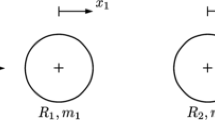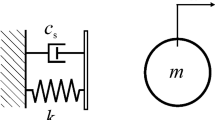Abstract
Based on a general methodology using naturalco-ordinates, a three-dimensional whole body responsemodel for the articulated human body is presented inthis paper. The joints between biomechanical segmentsare defined by forcing adjacent bodies to share commonpoints and vectors that are used in their definition.A realistic relative range of motion for the bodysegments is obtained introducing a set of penaltyforces in the model rather than setting up newunilateral constraints between the system components.These forces, representing the reaction momentsbetween segments of the human body model when thebiomechanical joints reach the limit of their range ofmotion, prevent the biomechanical model from achievingphysically unacceptable positions. Improved efficiencyin the integration process of the equations of motionis obtained using the augmented Lagrange formulation.The biomechanical model is finally applied indifferent situations of passive human motion such asthat observed in vehicle occupants during a crash orin an athlete during impact.
Similar content being viewed by others
References
Nigg, B.M. and Herzog, W., Biomechanics of the Musculo-Skeletal System, John Wiley and Sons, Toronto, 1994.
Prasad, P., ‘An overview of major occupant simulation models’, in Mathematical Simulation of Occupant and Vehicle Kinematics, SAE publication P-146, SAE paper No. 840855, 1984.
Laananen, D., Bolukbasi, A. and Coltman, J., ‘Computer simulation of an aircraft seat and occupant in a crash environment–Volume 1: Technical report’, US Department of Transportation, Federal Aviation Administration, Report No. DOT/FAA/CT-82/33-I, 1993.
Laananen, D., ‘Computer simulation of an aircraft seat and occupant(s) in a crash environment–Program SOM-LA/SOM-TA User manual’, US Department of Transportation, Federal Aviation Administration, Report No. DOT/FAA/CT-90/4, 1991.
Obergefell, L.A., Gordon, T.R. and Fleck, J.I., ‘Articulated total body model enhancements, Vol. 2: User's guide’, Report No. AAMRL-TR-88-043, Armstrong Aerospace Med. Research Lab., Wright Patterson Airforce Base, Dayton, Ohio, 1988.
TNO, Madymo User's Manual, Version 5.0, TNO, Delft, 1992.
Jalón, J.G. and Bayo, E., Kinematic and Dynamic Simulation of Multibody Systems, Springer-Verlag, Heidelberg, 1994.
Nikravesh, P.E. and Affifi, H.A., ‘Construction of the equations of motion for multibody dynamics using point and joint coordinates’, in Computer-Aided Analysis of Rigid and FlexibleMechanical Systems, M.S. Pereira and J.A.C. Ambrósio (eds), Kluwer Academic Publishers, Dordrecht, 1994, 31–60.
Nikravesh, P.E., Computer-Aided Analysis of Mechanical Systems, Prentice-Hall, Englewood-Cliffs, NJ. 1988.
Haug, E.J., Computer Aided Kinematics and Dynamics of Mechanical Systems, Allyn and Bacon, Chicago, 1989.
Bayo, E. and Ledesma, R., ‘Augmented Lagrangian and mass-orthogonal projection methods for constrained multibody dynamics’, Journal of Nonlinear Dynamics 9, 1996, 113–130.
Avello, A. and Bayo, E., ‘A singularity-free penalty formulation for the dynamics of constrained multibody systems’, Mechanical Design and Synthesis, ASME DE-Vol. 1, 1992, 643–649.
Gear, C.W., ‘Numerical solution of differential-algebraic equations, IEE Transactions on Circuit Theory CT-18, 1981, 89–95.
Lankarani, H., Ma, D. and Menon, R., ‘Impact dynamics of multibody mechanical systems and application to crash responses of aircraft occupant/structure’, in Computational Dynamics in Multibody Systems, M.F.O.S. Pereira and J.A.C. Ambrósio (eds), Kluwer Academic Publishers, Dordrecht, 1995, 239–265.
Love, A.E.H., A Treatise on the Mathematical Theory of Elasticity, 4th edition, Dover Publications, New York, 1944.
Silva, M.S.T and Ambrósio, J.A.C., ‘Modelo Biomecânico Para A Dinâmica Computacional Do Movimento Humano Articulado’ (Biomechanical model for the computational dynamics of the human articulated motion), Technical Report IDMEC/CPM-96/003, IDMEC–Instituto Superior Técnico, 1996.
CIBAGEIGY, Folia Rheumatologica,Motilit ät vonHüfte, Schulter, Hand und Fuß, CIBAGEIGY GrubH Wehr/ Baden, 1979.
Wismans, J.S., Janssen, E.G., Beusenberg, M., Koppens, W.P. and Lupker, H.A., ‘Injury biomechanics’, Third term W-3.3, WMT-3.3, code 4J610, Faculty of Mechanical Engineering, Eindhoven University of Technology, 1994.
Author information
Authors and Affiliations
Rights and permissions
About this article
Cite this article
Silva, M., Ambrósio, J. & Pereira, M. Biomechanical Model with Joint Resistance for Impact Simulation. Multibody System Dynamics 1, 65–84 (1997). https://doi.org/10.1023/A:1009700405340
Issue Date:
DOI: https://doi.org/10.1023/A:1009700405340




